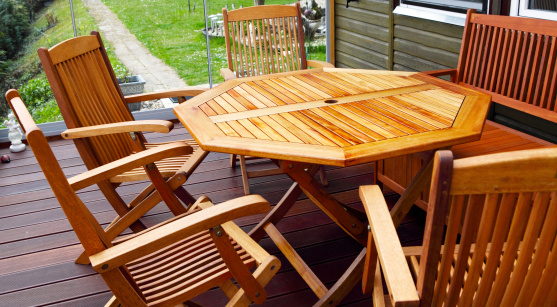
We’re in the midst of the rainy season right now and as wonderful as a week of rain is for our gardens, the rest of our outdoor area can take a bit of a beating. In particular an outdoor setting can suffer considerable damage if left out in the open. This extends beyond winter as well; even in the warmer months steps need to be taken to ensure outdoor furniture is adequately protected from the sun, UV radiation, rain and other moisture.
Think about positioning
The easiest way to protect your furniture is to keep it out of reach of the elements. If possible place your setting under a pergola or shade to shelter it, as direct sunlight will cause upholstery and wood to fade faster and rain encourage rot and warping. If out in the open, try and move it to a garage or shed during prolonged rain or stormy events. Even if your furniture is undercover think about its placement, as furniture near the edge of any covering will likely still suffer rain from the wind and some sun exposure.
Apply seasonal protective coatings
Depending on the type of material of your outdoor setting there are a number of protective coatings you can use.
Make sure to clean your furniture thoroughly first before applying any coatings and remove any rust spots; avoid concentrated cleaning products as these may strip away existing protective coats and check which product is right for your material before use. With plastic do not use abrasive cleaners as they can roughen the plastic and make it more brittle. With all materials it is advisable to test a small area first to ensure the cleaning product doesn’t fade it or cause damage. Once clean make sure to leave it until it is totally dry before applying any kind of coating.
The strongest protection for outdoor furniture is paint with UV protection, or for metal furniture paint with added rust protection. It does tend to peel every few years and will need to be reapplied.
Water sealants are essential for wood as not only do they prevent water from being absorbed into the furniture they also enable it to evaporate faster, providing protection against warping, splitting and rotting. When water penetrates the grain it causes the wood to expand and as it dries it contracts, causing cracks that gradually get wider. Again these will need to be reapplied every few years depending on how extreme your local weather is. The appropriate sealant depends on the type of wood so be sure to pay attention to the right one for your furniture.
Metal furniture is elegant and durable but unfortunately prone to rust so it's best to invest in and apply outdoor paste wax. If you see it bubbling or peeling use sandpaper to lightly remove the damaged area and then reapply. Keep an eye out for bird droppings as these are strongly acidic and will wear it away faster, so try to remove them as soon as you notice.
Don’t forget the upholstery! After cleaning make sure each piece has been sprayed with fabric protector. Again make sure to read and test the can to ensure it is suitable for your material.
Inspect your furniture regularly
Make sure you examine your furniture on a regular basis so you can make repairs before the problems spread and it becomes unsalvageable. Check for cracks, loose bolts, paint chips and fading, and watch metal for rust spots. Rust spots can be gently scrubbed away with sandpaper or a wire brush, bolts can be tightened, paint reapplied to provide a protective barrier and cracks can sometimes be fixed with special glues. With wicker furniture check the weave with your fingers and push it back into place if there has been any shifting. Make sure to clean your furniture regularly and reapply protective sealants.
Covers
Make sure to invest in furniture covers and cover your furniture in winter. Covers offer limited protection but can guard against rain and provide some UV cover. If possible it is best to get custom covers so your furniture is properly covered and protected from the elements. If you don't have a custom cover use a waterproof tarp in times of wet weather, tied down with rope to ensure it doesn't fall or get blown away.
Raise it up
Use furniture glides to raise the legs of your furniture from the ground. This prevents them from prolonged water soaking in either puddles of rainwater or wet grass.
A few simple steps and a bit of care can make your outdoor setting last the distance.
Hi there,
Would you like to receive home decor
ideas and DIY tips to your inbox?
Subscribe to our mailing list!

